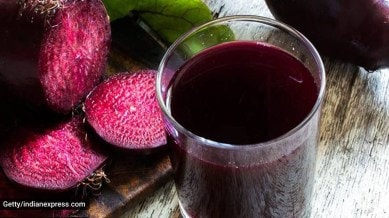📣 For more lifestyle news, click here to join our WhatsApp Channel and also follow us on Instagram
No! Pomegranate and beetroot are not the best sources of iron in the body; here’s why
There are foods that have at least "3 or more times the iron than in pomegranates/beetroot", said Dr Dilip Gude, senior consultant physician, Yashoda Hospitals, Hyderabad

The recommended dietary allowance of iron usually is about 10mg per day. Considering that many suggest the inclusion of beetroot and pomegranate in their diet. Additionally, as they are red in colour, they are touted to be good for tackling iron deficiency anaemia by increasing blood in the body.
But nutritionist Juhi Kapoor urged that they are not the best sources of iron.
“It is a big misconception that beetroot and pomegranate are rich sources of iron. Beetroot has only 0.76 mg of iron per 100 gram and pomegranate has only 0.31 mg of iron per hundred gram which makes both of these foods poor sources of iron,” said Kapoor.
She also mentioned that the deep red colour is actually because of natural pigments or polyphenols and as such this deep red colour has nothing to do with its iron content.
Concurred Dr Dilip Gude, senior consultant physician, Yashoda Hospitals, Hyderabad, and shared that beetroot contains lots of vitamin A, most times more than the recommended daily allowance. “The fat-soluble nature of vitamin A can make constant excess storage which may make the body hard to eliminate. High levels of beetroot may cause a decrease in blood pressure and may cause mild allergic reactions. Also, the high calcium oxalate in beetroots may impede calcium absorption, increase the risk of kidney stones, and cause stomach upset,” said Dr Gude.
Food has two types of iron
1) Heme – found in meat, fish and poultry. Nutritionist Prernna Kalra explained that it is readily absorbed by the body. “Usually 30 per cent of it is absorbed,” said Kalra.
2) Non-Heme iron- found in fruits, vegetables, and nuts. “But the iron contained in these foods will not be absorbed completely. Generally 2-10 per cent only absorbed by the body,” said Kalra.
But remember it doesn’t mean beetroot and pomegranate will not help you in making iron. “It will definitely help you in making red blood cells but slowly,” said Kalra.
What are the best sources of iron?
Some of the best sources of iron include organ meats (liver etc). “Meat such as chicken, lamb, oysters, mussels, clam are excellent sources of dietary iron,” said Dr Gude.
According to Dr Gude, broccoli, string beans, dark leafy greens, like dandelion, collard, kale and spinach, prunes, raisins and apricots, eggs, beans, nuts, peas, lentils, and tofu are all rich in iron and strongly encouraged. “These foods have at least 3 or more times the recommended dietary allowance of iron than in pomegranates/beetroot and hence strongly recommended,” said Dr Gude.
What to keep in mind? Whenever you consume iron-rich food, do not forget to take vitamin C-rich food like tomatoes, citrus fruits, and red and yellow bell peppers which help absorb iron in a better way.
📣 For more lifestyle news, click here to join our WhatsApp Channel and also follow us on Instagram